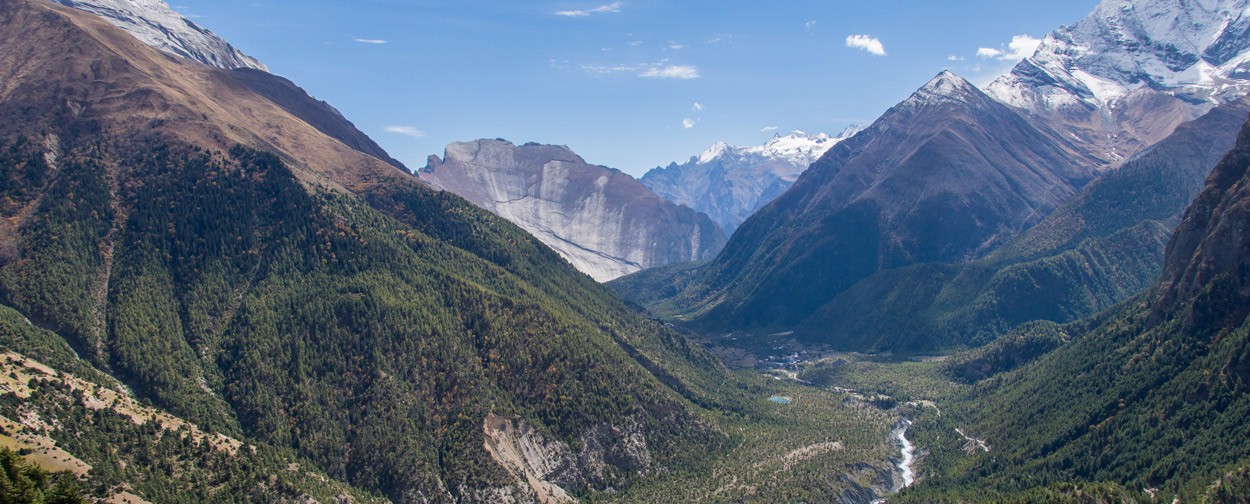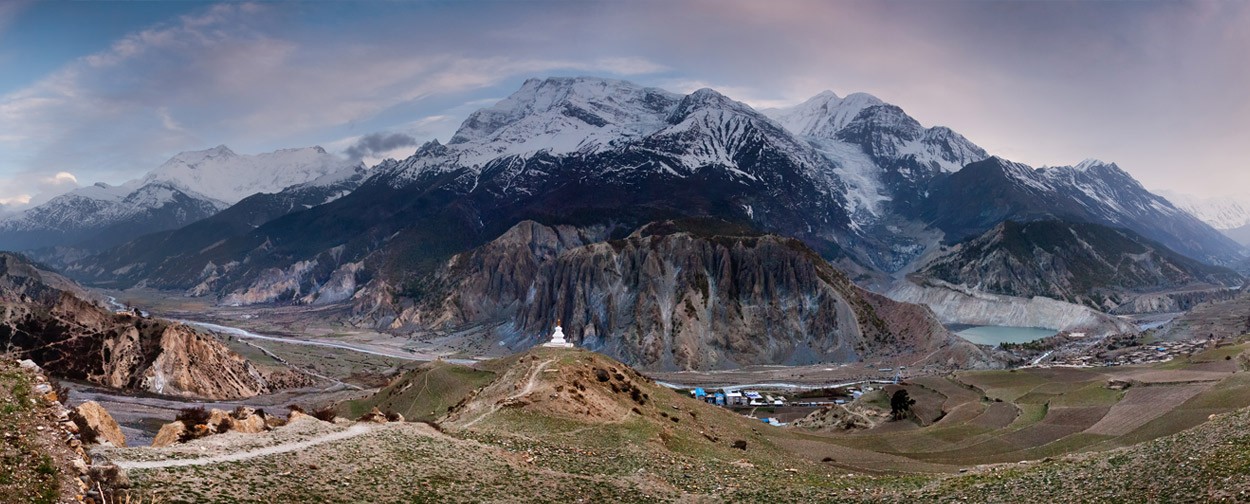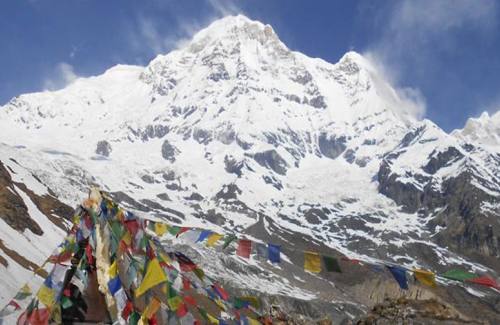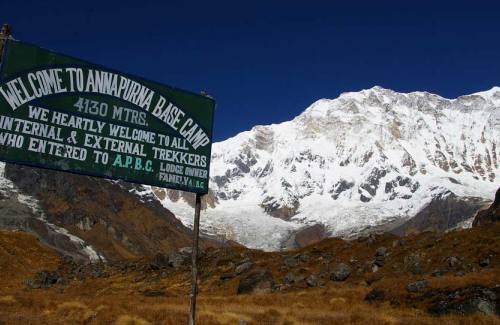Annapurna Circuit Trek
-
Starting Price (P/P) US$ 1875
-
Trip Duration 21 Days
-
Max. Altitude 5,416m.
-
Min. Group Size 02 Person
Trip Facts
- Destination:Nepal
- Trip Grade:Moderate
- Meals:Breakfast, Lunch and Dinner
- Transportation:Private Vehicle/Tourist Bus
- Trekking Style:Trekking and tour
- Accommodation:Lodge to lodge
A magical journey around the entire Annapurna massif reaching the Zenith of Thorong La Pass at 5416m.
The classic trek in the Annapurna region is the Annapurna Circuit. The complete circuit has only been possible since the mid 1980’s when Manang area was officially opened up to non-Nepalese visitors. For an all-round experience of the scenery and cultures of Nepal this trek has a lot to offer. Starting in the lush Marshyangdi Valley, that separates the Annapurna range from that of Manaslu, the scenery is composed of lush cultivated fields with dense forests on either side. In the winter season, orange trees are laden with fruit and fragrant frangipani blossoms cast their scent along the trails. As you travel higher, the valley becomes more rugged until the villages and forests finally give way to the arid hills of Manang. The Thorong La pass, at 5416 meters, marks the high point of the trek after which the trail joins the Kali Gandaki River that flows through the deepest gorge on earth.
This is a challenging trek that is not without some risks. The crossing of Thorong La can be dangerous at times, especially during unexpected snowfall, so potential trekkers must make sure that they are well prepared and equipped for all eventualities. If a few extra days are allowed for, it is then possible to enjoy several of the possible side trips and add immeasurably to the experience. An entry permit for the Annapurna Conservation Area Project (ACAP) is needed for this trek.
Most trekkers start the trek by taking the bus from Kathmandu to Besishahar. These days the journey is accomplished in around five or six hours which allows a few hours trekking on the first day. The trail from Besishahar follows the partly constructed road as far as the small market town of Khudi. This road can be avoided by crossing the river below Besishahar and trekking along the east bank of the river rejoining the main trail at Bhulbhule.
The first few days of the trek follow the Marshyangdi through scattered farming communities inhabited by a mixture predominantly composed of Gurungs but with a sizeable number of Brahmin communities. The crops range from rice and wheat at the lower elevations to corn, millet and barley as the altitude increases. Above the valley floor the hills are cloaked in forest with the occasional clearing indicating human settlements. Higher still, the snowy peaks of the Annapurna and Manaslu ranges dominate the skyline. A feature of this section of the trek is the number of high water falls that cascade down into the main river. The valley rises slowly so altitude sickness is rarely a problem at this stage.
After four days on the trail, the river which has been flowing from the north changes its course and flows from the west. At this point the landscape changes with steep rocky gorges on each side and large stands of pine making up the forest cover. By the time the district headquarters of Chame has been passed the hills are becoming more and more barren and the people predominantly Manangba. Look for a number of ancient temples, some of which represents the pre-Buddhist, Bon religion.
The tree like is reached a few hours before arriving at Manang where a compulsory rest day should be taken for acclimatisation to the increasing altitude. There are a number of possible side trips from Manang that can be taken on the acclimatisation day. Perhaps the most spectacular is to the west, across the river and up to the Gangapurna glacier with its deep blue lake formed by the melting glacial ice. The Himalayan Rescue Association clinic is located in Manang village and holds afternoon awareness lectures for trekkers warning of the danger of AMS. These lectures are well worth attending.
From Manang, the trail passes through high alpine pastures until the small cluster of teahouses at Thorong Phedi is reached. An early morning start form here will allow you to reach Thorong La by mid morning and then start the long descent across the scree slopes to Muktinath before the afternoon cloud sweeps in. this whole section has no permanent settlements and shelter is hard to find. For safety, trekkers should never travel alone along this section.
Muktinath, a famed pilgrimage site for both Buddhists and Hindus, is the first major settlement reached after the crossing of Thorong La. Be sure to visit the temples here and especially look for the eternal flame, fuelled by natural gas, which can be found in the small Buddhist temple below the main shrine.
From Muktinath the views to the west are now of the Dhaulagiri range while to the north can be seen the arid hills of Upper Mustang. The trail leads down through villages inhabited by people of Tibetan stock until it reaches the banks of the Kali Gandaki River, the home of the Thakali people. A further four days trekking down though this, the deepest valley on earth, brings you to the road head at Beni from where buses to Pokhara can be found. Settlements of particular interest below Muktinath are Jomsom with its airport, a possible exit point to Pokhara, Marpha with its fascinating medieval architecture designed toward off the fierce winds that blow daily up the gorge and Tatopani with its hot springs.
There are a number of possible side trips that can be combined with the Annapurna Circuit. Either from the Manang side or from below Jomsom it is possible to trek up to the high altitude lake at Tilicho. You must allow at least four days for this trek and be fully self-sufficient. Also on the eastern side of the Kali Gandaki there is a trail that leads to the original North Annapurna Base Camp that was used by the French expedition that first scaled the peak. On the western side of the valley treks to Hidden valley via Dhampus pass and to the Dhaulagiri icefall are also possible options. All of these side trips are suitable only for fit and experienced parties who are fully self-sufficient.
Day
1Arrival in Kathmandu 1300m/4264ft
Welcome to Nepal! A friendly representative from Purple Journeys will meet-and-greet you at the arrival area of the Tribhuvan International Airport with a flower garland – a tradition gesture of Nepalese hospitality. You will then be ushered to your pre-booked hotel. Unwind from your flight and meet us in the evening at a traditional Nepalese restaurant for a fine meal accompanied by folk music and a cultural program.
2Kathmandu Sightseeing and trip prepration
Explore the cultural treasures of Kathmandu in our guided tour and immerse yourself in the vibrant array of bustling streets, incomparable historic buildings and heritage, exquisite temples and religious sites. The tour includes the holiest Hindu pilgrimage site of Pashupatinath Temple, the colossal stupa of Bouddhanath, Swoyambhunath Stupa also known as The Monkey Temple and the historic Kathmandu Durbar Square with ‘Kumari Ghar’. There will also be time for shopping, picking up a thing or two for your trekking, if you have not done it back home. In the evening, we will have a pre-trek discussion and familiarize with our leader, other crew and participants.
3Drive from Kathmandu to Besisahar to Khudi 800m/2624ft: 8 hours drive. 1 hour walk.
Depart Kathmandu after breakfast by private vehicle. We follow the Trishuli River toward Pokhara through the pastoral beauty of Nepal’s verdant middle hills. Exiting the highway to Pokhara at Dumre, we arrive at Besisahar. From Besisahar, we further drive for about half an hour to reach our trailhead at Khudi.
4Trek from Khudi to Sirung 2200m/7216ft: 6 -7 hours walk
The trek begins in the subtropical Annapurna foothills, a scenic landscape marked by lush vegetation, waterfalls, and rural settlements surrounded by terraced farmlands and grazing buffalo. Several climbs and descents will take us to Sirung, from where our first view of the Manaslu range can be seen upon the horizon.
5Trek from Sirung to Chamje 1410m/4626ft: 5 – 6 hours walk
Following the Marsyangdi River, we traverse the base of a steep cliff, passing numerous picturesque villages. The trail gradually steepens as we approach Jagat, finishing with a tough climb to Chamje.
6Trek from Chamje to Dharapani 1960m/6430ft: 5 – 6 hours walk
Entering the Manang region, we traverse a landscape of forested areas and fields of barley, potatoes, and corn. The generally flat trail passes through Tal village, where we stop for lunch near the base of a waterfall, and further on to Dharapani.
7Trek from Dharapani to Chame 2710m/8891ft: 5 – 6 hours walk
Passing over several ridgelines we ascend gradually into the hills. As the trail presses higher, we are rewarded with glimpses of the snowcapped Annapurnas and LamjungHimal on the horizon.
8Trek from Chame to Pisang 3300m/10824ft: 5 - 6 hours walk
The morning’s climb through thick forest will take us to a rocky plateau high above the Marsyangdi River. Several river crossings along suspension bridges will bring us to a scenic expanse of the Manang valley, surrounded by soaring peaks, a dramatic change of scenery as arrive in Pisang.
9Trek from Pisang to Manang 3500m/11482ft: 6 – 7 hours walk
Dramatic scenery unfolds as we ascend through upper Pisang into a mountainous landscape surrounded by the Pisang and Annapurna peaks. We stop at Barge to visit Manang’s largest monastery en route to Manang Village.
10Rest day in Manang Village
We spend a day acclimatizing around Manang Village in preparation for the coming days of rapid altitude gains. Several points of interest are easily accessible from Manang, including Gangapurnalake and the Buddhist Gompa at Bhojo.
11Trek from Manang to Yak Kharka 4110m/13484ft: 3 - 4 hours walk
Ascending out of the Marsyangdi Valley via the adjacent JarsangKhola Valley, we pass through Ghunsa, a tiny mountain village surrounded by yak pastures. The trail continues with a river crossing and past an ancient Mani wall, finally arriving at Yak Kharka.
12Trek from Yak Kharka to ThorongPhedi 4600m/15092ft: 3 – 4 hours walk
A steady ascent across stark and rugged terrain will bring us to ThorongPhedi, a bustling town used often as a base camp for expeditions in the region. We’ll arrive early to allow us to rest for tomorrow’s crossing of the famous Thorong La.
13Trek from ThorongPhedi across Thorong La 5416m/17764ft and Muktinath 3800/12467ft: 7 – 8 hours walk
Today’s crossing of the epic Thorong La will prove to be a highlight of your trip, and an experience you’ll never forget. The combination of physical challenge and remarkable high mountain scenery will leave you in a state of awe. We’ll descend as the sun sets over a spectacular horizon to Muktinath, a holy pilgrimage site for both Buddhists and Hindus.
14Trek from Muktinath to Marpha 2670m/8760ft: 4 – 5 hours walk
After exploring the famous temple of Vishnu and monastery in Muktinath, we’ll descend steeply down the side of the Kali Gandaki Gorge, the world’s deepest river gorge. Passing through Kagbeni and Jomsom, we’ll arrive in Marpha, Nepal’s apple capital, where the country’s famous apple brandy is produced.
15Trek from Marpha to Kalopani 2530m/8300ft: 5 – 6 hours walk
Departing Marpha, we’ll pass through a charming landscape of apple orchards en route to the Thakali village of Chokhopani. From Chokhopani an incredible panoramic view of Dhaulagiri, Tukuche, Annapurna I, Fang, and Nilgiri I, II, and III awaits. A short descent and a river crossing will bring us to our overnight stop at Kalopani.
16Trek from Kalopani to Tatopani 1200m/3937ft: 6 – 7 hours walk
Crossing the bridge near Ghasa, we descend into a densely forested area before reaching the famous waterfall RupseChahara. Passing several villages along our descent and a hydropower facility at NarchyangBesi, we arrive in Tatopani, famous for its hot spring baths – a welcome relief after our days of walking.
17Trek from Tatopani to Ghorepani 2850m/9350ft: 7 – 8 hours walk
Today brings us through an area inhabited by a variety of hill dwelling villagers en route Ghorepani. Our trail meanders past pastoral villages and through stretches of peaceful forest, ending with a steep climb to the bustling town of Ghorepani.
18Trek from Ghorepani to Tadapani 2710m/8891ft: 6 – 7 hours walk
This morning will be another trip highlight. The early wake up and steep climb to the lookout at Poon Hill will reward us with spectacular views. The panorama from Poon Hill is said to be one of the best viewpoints in the Annapurnas. After an unforgettable sunrise, we’ll follow a winding trail down to Tadapani.
19Trek from Tadapani to Ghandruk to Pokhara 850m/2789ft: 5 – 6 hours walk, 1 hour drive
The journey commences with a pleasant stroll through the hillsides to Ghandruk, Nepal’s second largest Gurung settlement. We’ll stop to visit the cultural museum and enjoy the colorful bazaar in Ghandruk. From here it’s a short walk to Nayapul, the last stop on our trek, from where we’ll board a bus for the short drive to Pokhara.
20Drive from Pokhara to Kathmandu: 6 hour drive
After breakfast, we’ll board our bus bound for Kathmandu, arriving in the evening in time to relax in Thamel and enjoy a farewell dinner.
21Depart Kathmandu
Take care of any last minute shopping or sightseeing as time permits. You’ll be picked up at your hotel three hours prior to your departure flight. Thanks for traveling with Purple Journeys. Farewell and Namaste.
WHAT'S INCLUDED
- Airport pickup and drop off in private vehicle
- Hotel with included breakfast in Kathmandu
- Private transportation and government licensed guide while sightseeing in Kathmandu valley
- Entrance fees for attractions (UNESCO world heritage sites, museums, etc.) during sightseeing in Kathmandu
- Government licensed, experienced trekking guide and porters during trekking
- Insurance for trekking crew (guides and porters)
- Accommodations in tea-houses during trekking
- Three daily meals while trekking
- All required conservation fees and trekking permits (TIMS)
- Air ticket to and from Nepal from your point of origin
- Visa fee for entry into Nepal
- Meals while in Kathmandu and Pokhara unless otherwise mentioned in the itinerary
- Personal insurance or cost of air rescue in the event of emergency
- Personal expenses (souvenirs, alcoholic beverages, hygiene items, staff tips, etc.)
Trip Map
SIMILAR PACKAGES
You may also like these tripsAFFILIATIONS









